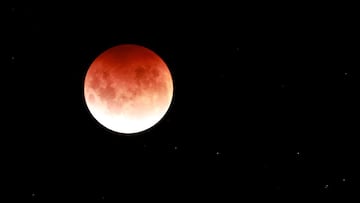Super Flower Blood Moon: times and how to watch online, outside
As long as the weather plays ball, a total lunar eclipse will be visible across the United States late on Sunday and early on Monday.


For just under an hour and a half, a total lunar eclipse will be visible across the United States late on Sunday and early on Monday - weather permitting.
Known as a Super Flower Blood Moon, the eclipse will be visible from start to finish in the eastern half of the US, while those in the west of the country will miss the initial stages, but not the peak phase of the event.
What is a total lunar eclipse?
A total lunar eclipse occurs when Earth moves between the Sun and a full Moon, leaving the Moon in the darkest part of the planet’s shadow, which is known as the umbra.
Either side of the total eclipse, two other kinds of eclipse also take place: a penumbral eclipse, during which the Moon is in Earth’s penumbra, its outer shadow; and a partial eclipse, during which some, but not all, of the Moon is in the Earth’s umbra.
Why is it called a Super Flower Blood Moon?
Let’s take this in stages, from back to front.
‘Blood’ refers to the reddish hue the Moon takes on from our viewpoint during a total lunar eclipse. This is because all of the sunlight that reaches the Moon during a total eclipse must first pass through Earth’s atmosphere, and due to the way light waves interact with our atmosphere, only red, orange and yellow light waves travel onwards towards the Moon. Blue light is scattered away.
‘Flower’ is among the names given to May’s Moon. Originally used by Native Americans, it refers to the fact that “in most areas of the northern hemisphere, flowers are abundant in late spring”, the Old Farmers’ Almanac explains.
Finally, ‘super’ is tacked on to the beginning of the name because May 2022′s full Moon qualifies as a ‘Supermoon’. A term coined by the astrologer Richard Nolle in the late 1970s, it refers to a new or full Moon that’s within 90% of perigree, the satellite’s closest position relative to Earth. Per NASA, a full Supermoon appears some 14% bigger than a full Moon at its furthest point from the Earth.
So, in summary, Super Flower Blood Moon translates as: a total lunar eclipse in the month of May, when the Moon is at, or near, its closest point relative to Earth.

When is the total lunar eclipse?
The eclipse process will get going at 9:32pm ET on Sunday 15 May, with totality - the period in which the Moon is completely inside Earth’s umbra - starting at 11:29pm ET and peaking at 12:12am. In all, the total eclipse phase will last for 84 minutes.
While the whole of the US will be able to see the eclipse at totality (again, weather permitting), those in the west will miss the earlier stages, because the Moon will still be below the horizon at that point.
According to NASA, the timings of the total lunar eclipse are as follows:
- 9:32pm ET/6:32pm PT*: penumbral eclipse begins (Moon enters penumbra)
- 10:27pm/7:27pm PT*: partial eclipse begins (Moon begins entering umbra)
- 11:29pmET/8:29pm PT: total eclipse begins (Moon now inside umbra)
- 12:12amET/9:12pm PT: total lunar eclipse reaches peak
- 12:53amET/9:53pm PT: total eclipse ends (Moon begins exiting umbra)
- 1:55am ET/10:55pm PT: partial eclipse ends (Moon leaves umbra completely)
- 2:50am ET/11:50pm PT: penumbral eclipse ends (Moon leaves penumbra)
*not visible in PT time zone
Viewing the total lunar eclipse outside
Unlike a solar eclipse, you do not need special glasses to view a lunar eclipse. “Binoculars or a telescope will enhance the view and the red color,” NASA advises, adding: “A dark environment away from bright lights makes for the best viewing conditions.”
According to Accuweather.com, much of the east coast of the US may well have its view of the Super Flower Blood Moon hindered by cloud cover. “The chances of seeing the eclipse are much higher across the central and western U.S. with partly to mainly clear conditions in the forecast on Sunday night,” the service says.
Total lunar eclipse: live streams
There are a number of live online streams offering footage and expert coverage of the Super Flower Blood Moon.
For example, NASA will have an online watch-along beginning at 9:32pm ET. “Join NASA experts to learn about this incredible natural phenomenon, look through telescope views across the world, and hear about plans to return humans to the lunar surface with the Artemis program,” the agency says.
Related stories
TimeandDate.com will also be offering a live video of the event. “Our live coverage is your perfect companion to this eclipse, whether it’s visible from your location or not. Follow the eclipse from start to finish with us,” the site says.
Another option is the live stream put on by the Lowell Observatory in Flagstaff, Arizona. “Watch eclipse-themed presentations from members of Lowell’s superstar staff and enjoy live views of the eclipse as it approaches totality in our pristine dark skies!” the observatory says.

